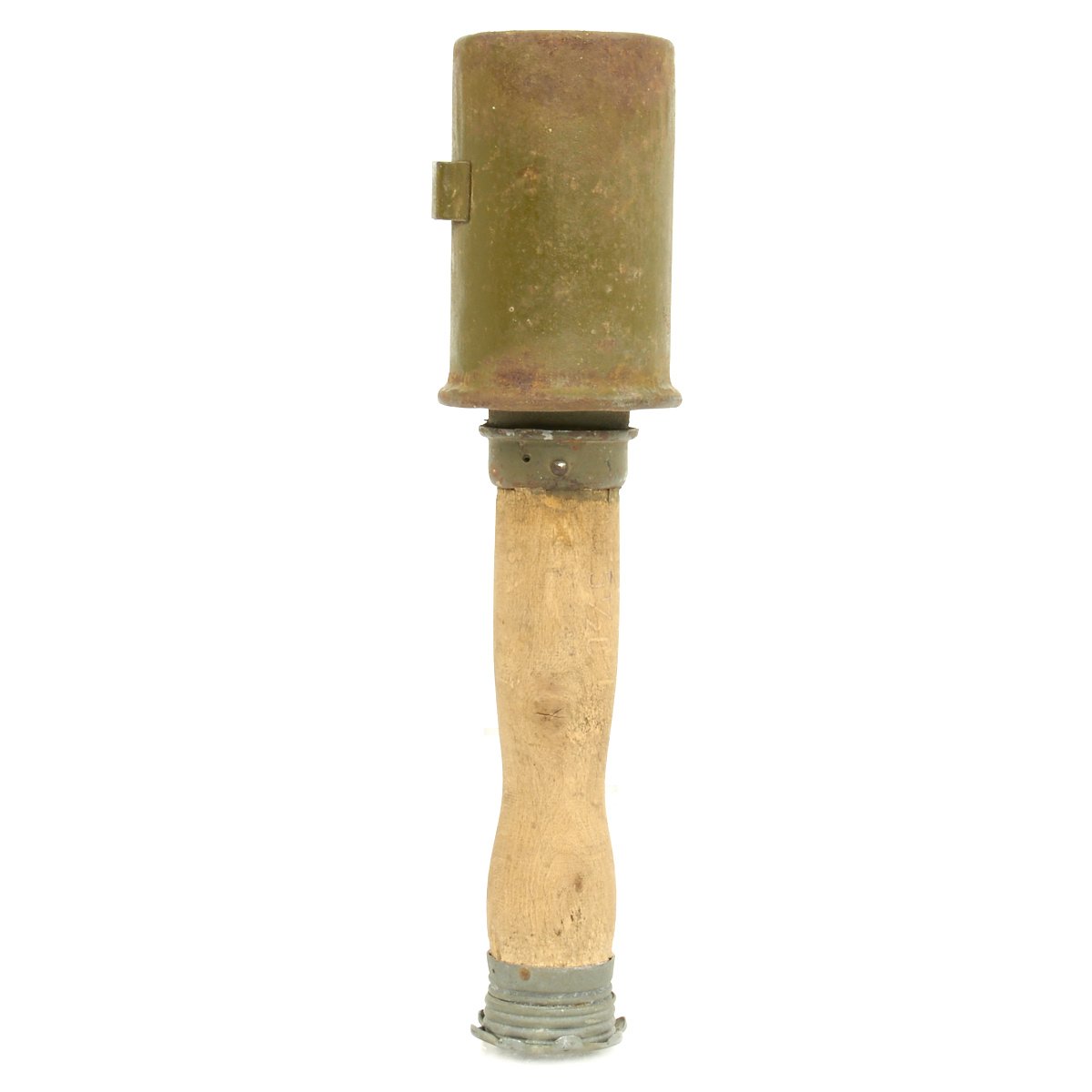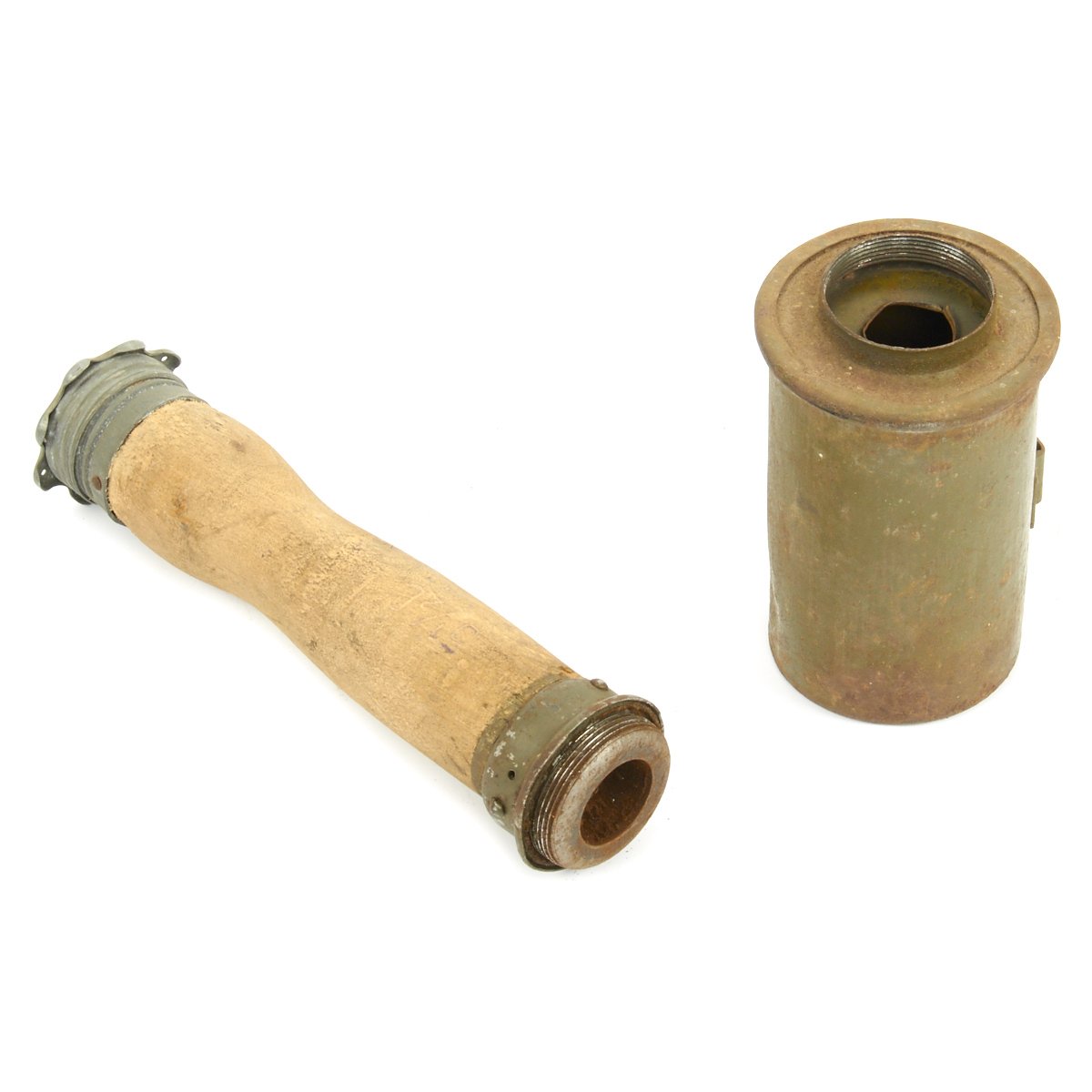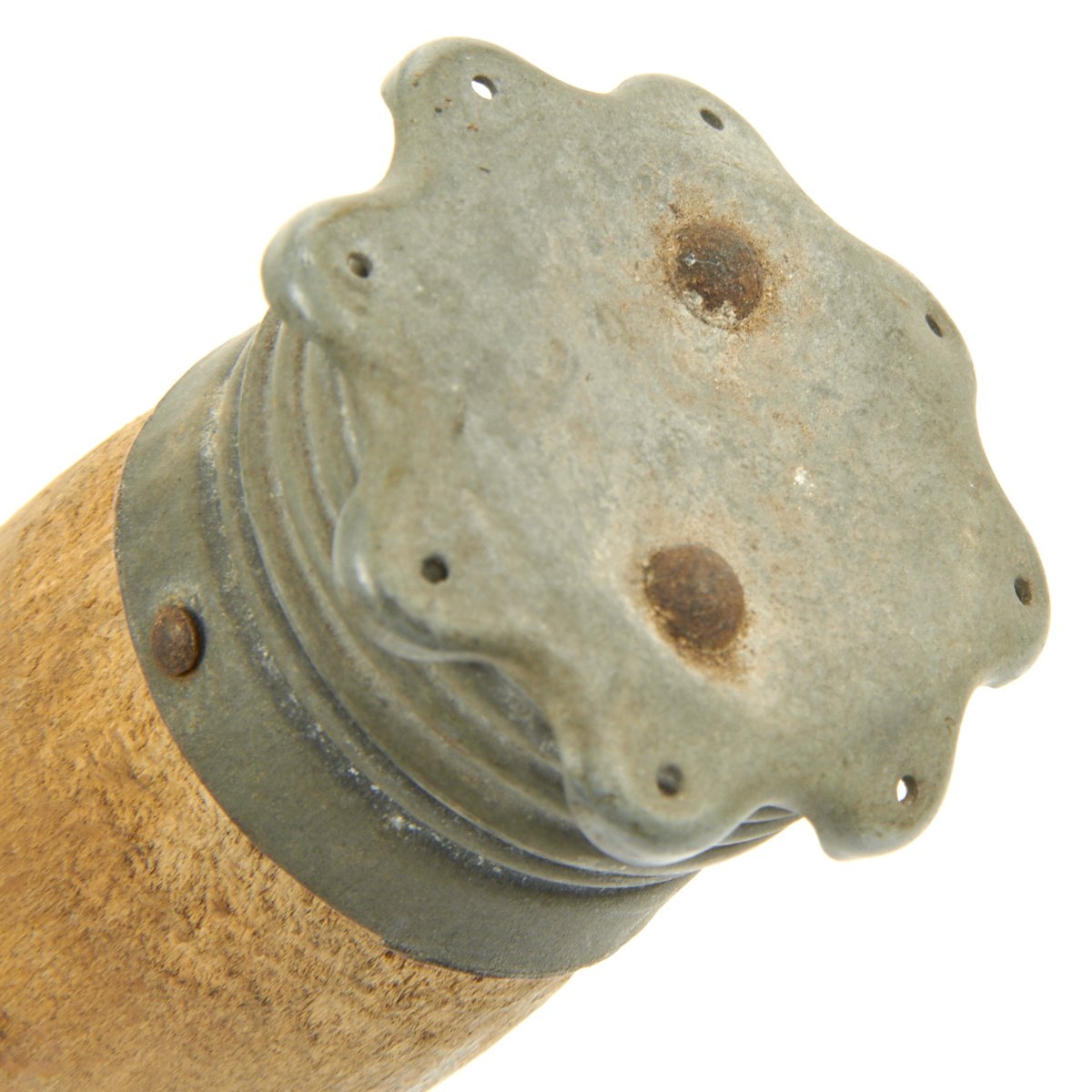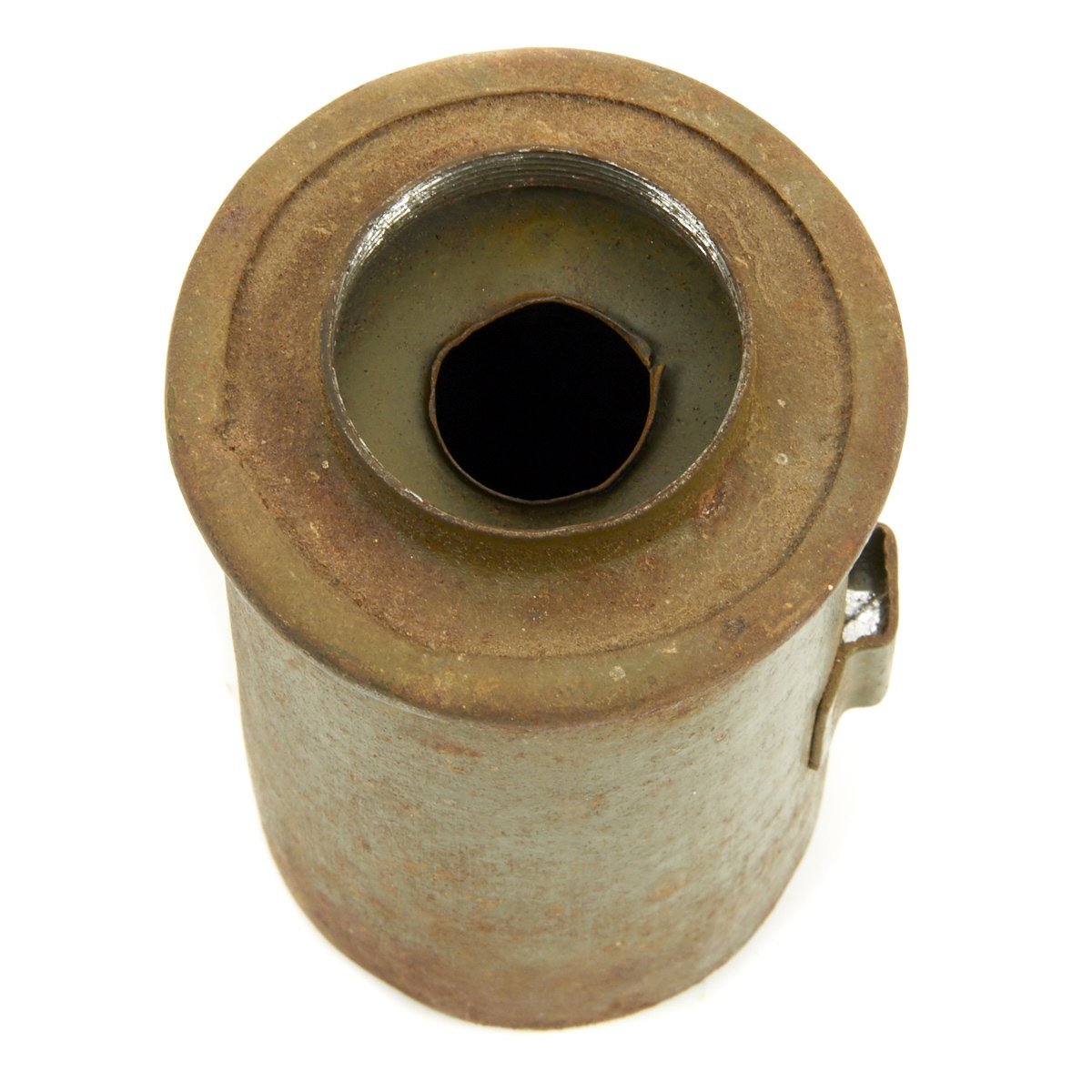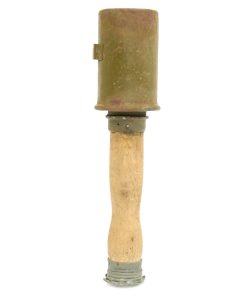Original German WWI Model 1916 Stick Grenade – Stielhandgranate M16 Original Items
$ 695,00 $ 208,50
Original Item: Only One Available. This is a very good condition totally genuine BATF approved inert German WWI M16 Stick Grenade known as the Model 1916 Stielhandgranate. This example has a screw off head, star shaped screw off base cap (which is stuck), a hollow stick and still retains its original paint. It stands 11 inches tall with a head diameter of 8 inches. These are exceptionally rare far more difficult to find than the WWII M24 version.
Germany entered World War I with a single grenade design: a heavy 750-gram (26 oz) ball-shaped fragmentation grenade (Kugelhandgranate) for use only by pioneers in attacking fortifications. It was too heavy for regular use on the battlefield by untrained troops and not suitable for mass production. This left Germany without a standard-issue grenade and improvised designs similar to those of the British were used until a proper grenade could be supplied.
The ‘stick grenade’ first appeared in the midst of World War I; it was introduced in 1915 for use by the German Empire’s armed forces. As time went on, the design further developed, adding and removing certain features. Aside from its unique and unusual appearance, the Stielhandgranate used a friction igniter system, a method very uncommon in other nations but widely used in German grenades.
During World War I, the original design of the Stielhandgranate, under the name M1915 (Model 1915), was in direct technological competition with the British standard-issue Mills bomb series. The first design model of the Mills bomb – the Grenade No. 5 Mk. 1 – was introduced the same year as the German Model 1915, but due to delays in manufacturing it was not widely distributed into general service until 1916. (There was a small period of time where German troops had large supplies of new Model 1915 grenades, while their British opponents only had a very small number.)
As World War I progressed, the Model 1915 Stielhandgranate was further improved with various changes. These received new designations corresponding for the year of introduction, such as the Model 1916 and the Model 1917.
Production variations
Model 1915 (M15)
In 1915, industries of the German Empire designed and began production of the original Stielhandgranate, appropriately named Model 1915 (M15). It utilized a priming system, unlike the percussion cap pin used in most grenades of the period. The easily recognizable “potato masher” shape is a result of a number of different styles and choices of the design. The grenade mounted a charge head within a sheet-steel cylinder atop a long hollow-wooden handle. Internally, the explosive – initially ammonal but later approximately 170 g (6.0 oz) of trinitrotoluene filling[3] – was connected to a detonator, and a pull cord ran from the detonator down the length of the hollow handle, emerging from the base. To use, a soldier would simply pull the string downwards, dragging a rough steel rod through the igniter within the fuse. The rod’s abrasive contact would cause sparks and a flame to light from within, setting the fuse burning. This fuse took approximately four and a half seconds to reach the detonator before exploding.
The Stielhandgranate’s handle design provided a lever motion in a throw, significantly improving the effective range of use. It could be thrown by the common German infantryman approximately 27 to 37 metres (30 to 40 yd), whereas the British Mills bomb could often only be thrown about 14 metres (15 yd).[4] The British War Office report “WO 291/472 Performance and handling of HE grenades” gives an average figure for a standing throw of a Mills bomb as 27 m (30 yd), (23 m (25 yd) when crouched and 22 m (24 yd) lying prone). One issue that hand grenades of the time had was unpredictable rolling after landing. The German Stielhandgranate did not suffer nearly as much, and in some respects not at all, from this problem as the handle together with the charge head resisted rolling. Instead of rolling straight down a hill or across rough terrain, the Stielhandgranate could create an axis for rotation: it would instead roll from side to side, because the charge head and length of the grenade acted as a balance. However, the additional length of the handle and the irregular overall shape meant that fewer grenades could be carried. It also took longer to prime the grenade than an allied counterpart, such as the Mills Bomb.
The Stielhandgranate primarily relied on a concussion blast effect, the container creating little fragmentation compared with many grenades of the time, such as the Mills Bomb and the French F1 Grenade, the later World War II American Mk 2 grenade, and the Soviet F1 Grenade. Fragmentation produced shrapnel which could wound enemy infantry over a large area, a factor which made these types of grenade very good for open areas, such as fields, the blasted expanse of no man’s land, beaches, spacious trenches, and wide city streets. Concussion grenades, on the other hand, based their wounding ability purely on the shock and blast of the explosives. The Stielhandgranate was extremely effective and reliable in clearing enclosed areas, such as buildings, fortifications, and the fighting compartment of an enemy tank. On the other hand, performance in wide open areas was less than satisfactory. The blast effect could only go so far before dying out, while pieces from an equivalent fragmentation grenade could fly hundreds of metres (it was not unrealistic to expect that metal shrapnel could hit a soldier that the grenade was not intended for, especially in open areas).
Model 1916 M16 Stielhandgranate
The original M15 grenade suffered from an unfortunate design issue. The pull cord which activated the grenade’s fuse extruded from the base and could get caught in debris or clutter on the battlefields of World War I, causing the fuse to be ignited, and the grenade to explode on the belt of an unaware infantryman. This resulted in the introduction of the Model 1916 (M16).
Functionally identical to the M15, the M16 included a vital change in the base design. A small porcelain ball was placed at the base of the grenade, attached directly to the pull cord. This prevented the string from being exposed. The small bead was partially enveloped in the wooden handle, meaning that some force was needed to pluck it out. Operation was nearly identical, except that a soldier no longer needed to pull the string itself. This improved version resistant to humidity thanks to its stick cap which screwed onto the bottom which concealed the ignition string. It was later improved by riveting a star-shaped plate which helped the unscrewing of the cap in muddy conditions (an oft encountered condition of the trenches).
Fast Shipping with Professional Packaging
Thanks to our longstanding association with UPS FedEx DHL, and other major international carriers, we are able to provide a range of shipping options. Our warehouse staff is expertly trained and will wrap your products according to our exact and precise specifications. Prior to shipping, your goods will be thoroughly examined and securely secured. We ship to thousands clients each day across multiple countries. This shows how we're dedicated to be the largest retailer on the internet. Warehouses and distribution centres can be located throughout Europe as well as the USA.
Note: Orders with more than one item will be assigned a processing date depending on the item.
Before shipping before shipping, we'll conduct a thorough inspection of the items you have ordered. Today, the majority of orders will be delivered within 48 hours. The delivery time will be between 3-7 days.
Returns
The stock is dynamic and we cannot completely manage it because multiple stakeholders are involved, including our factory and warehouse. So the actual stock may alter at any time. It's possible that you may not receive your order once the order has been made.
Our policy is valid for a period of 30 days. If you don't receive the product within 30 days, we are not able to issue a refund or an exchange.
You can only return an item if it is unused and in the same state as the day you received it. You must have the item in its original packaging.
Related products
Uncategorized
Uncategorized
Uncategorized
Uncategorized
Uncategorized
Uncategorized
Uncategorized
Uncategorized
Uncategorized
Uncategorized
Uncategorized
Uncategorized
Uncategorized
Uncategorized
Band of Brothers ORIGINAL GERMAN WWII Le. F.H. 18 10.5cm ARTILLERY PIECE Original Items
Uncategorized
Uncategorized
Armored Burgonet Helmet & Polearm from Scottish Castle Leith Hall Circa 1700 Original Items
Uncategorized
Uncategorized
Uncategorized
Uncategorized
